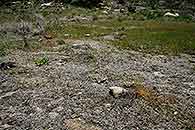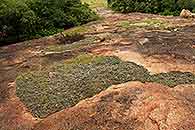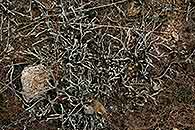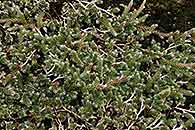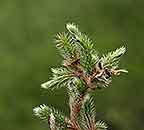Selaginella dregei (C. Presl) Hieron.
Synonyms |
Selaginella grisea Alston |
|---|---|
Common name |
|
Description |
Stems main stem up to 15 x 0.12 cm, creeping, branched, rooting freely, mat-forming; rhizophores spaced along the stem, 2-4 cm long, dark brown. Leaves overlapping around stem and branches, monomorphic, narrowly oblong to lanceolate in outline, margins ciliate, tips tapering to a point, with a curved white hair-like seta, one third to a quarter of the length of the blade, 1.5-3.0 × 0.15-0.3 mm, greyish to greyish-green turning silvery grey when dry. Strobili rarely develop, 4-8 mm long, suberect, with sporophylls terminal in 2 ranks, broader and more lanceolate than the leaves, ciliate and tapering to a point. |
Notes | S. dregei can be confused with S. caffrorum and S. nivea, these however have leaves with a shorter apical seta (less than a third of the leaf blade) and sporophylls that are arranged in 4 ranks. Crouch et all. (2011) seperate S. grisea from S. dregei, stating that apical leaf setae are about 1/3 the length of the leaf in S. dregei which is more robust with erect branches from a prostrate stem rather than being entirely prostrate; the marginal cilia are stronger and closer in S. grisea. |
Derivation | dregei: named after Johann Franz Drège (1794-1881), German horticulturalist, botanical collector and explorer who worked extensively in South Africa. |
Habitat | Forming dense mats occupying flat sheetrock in open and under scrub, in deciduous woodland and montane areas with rocky outcrops. |
Distribution worldwide | See African distribution. |
Distribution in Africa |
Angola, Botswana, Dem. Republic of Congo, Kenya, Malawi, Mozambique, South Africa, Swaziland, Tanzania , Uganda, Zambia, Zimbabwe. |
Growth form |
Lithophytic, terrestrial. |
Literature |
|

